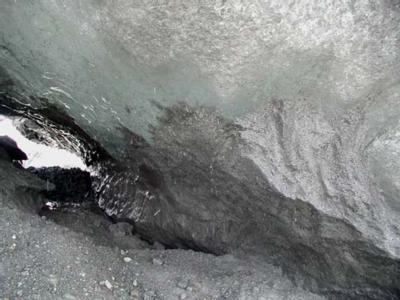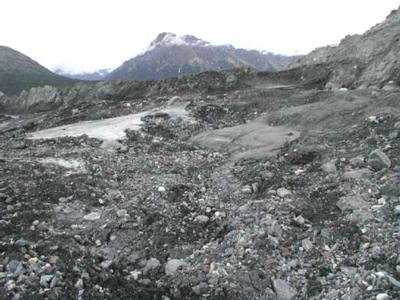28 July, 2000
July 28, 2000
Matanuska Glacier, Alaska
Temperatures were mild this morning as we got out early to collect last
night’s samples and reprogram the ISCOs to take our 9:00 am experiment.
We experienced some problems with them again however. We lost power to
the one at Mega Vent last night after it was half finished and we really
had no power at all at M-1 all night. With all the ISCOs being used, not
only by us but by the CRREL staff, there was a mix up on which batteries
were charged completely. Fortunately we believe we will get sufficient
samples to see the results at Mega Vent. We did manage to get two hours
of samples and in our previous tests the dye seemed to flush out in that
time. The other data at M-1 will be sorely missed. The batteries are
always strong enough that you can view the program screen and reprogram
the ISCO. But there is no way of knowing that it lacks the energy to
pump the samples into the rack. There used to be a voltmeter that could
verify the charge in the batteries but that broke a week or so ago and
was unavailable. To compound the problem we also lost some samples this
morning while we went back for fresh batteries. Those lost samples are
not too critical because we started the sampling at the same time we
poured the dye. It takes more than 30 minutes for the dye to appear at
the vents so we may miss a small part of the dye curve at the start. We
had fresh batteries installed at all three stations just in time for the
9:50 sample so we may miss just one sample containing a little dye.
We’ll have a look at bthem tomorrow.
In my July 21 journal I mentioned that we must filter all the glacial
flour from the samples before taking a reading with the fluorometer.
This material which results from rocks scraping against each other is
just one example of the erosive action of glaciers. Glaciers may be the
most efficient mechanism for erosion on earth. Whenever they move the
landscape is changed. As they move over bedrock they carry and drag a
load of sediment and rock called the “basal till layer”. It is this
layer which is frozen into the basal ice that polishes rocks and scrapes
away glacial flour by “abrasion”, much like sandpaper . Abrasion in
glaciers can produce materials up to several inches in size. In another
process called “glacier plucking” large blocks of bedrock can be lifted
and carried away once they have been loosened from the bedrock by
freezing and thawing of water in the cracks and fractures in the rock.
Some of these blocks can have dimensions as large as twenty-five feet.
As glaciers move through valleys they tend to change them into a
characteristic U-shaped through abrasion and plucking. Stream valleys
are generally V-shaped. The effect of all this is to widen and deepen
the valley. When this happens in coastal valleys the glacier often
erodes the valley floor to below sea level and can extend into the bays.
When the glacier eventually retreats through melting a deep water-filled
channel called a fjord is formed. Alaska has hundreds of fjords with the
best known being in the Inside Passage, Glacier Bay and Prince William
Sound.
There is evidence of this erosive power everywhere on and around the
Matanuska Glacier. These same processes shaped much of the landscape
near where I live in Indiana. It is extremely interesting and
educational to see these processes at work here. It is truly a hands-on
lab experience.
Marvin Giesting

This is an exposed piece of basal ice from the terminus. The darker layer of ice is the basal till layer and it is this layer that polishes rocks and scrapes away glacial flour.

This is an area of rock debris near the terminus and shows material of all sorts that has been transported by the glacier. You can see flows of small grain sediments as well as some larger boulders, all eroded and carried from the valley above by the glacier.
Contact the TEA in the field at
.
If you cannot connect through your browser, copy the
TEA's e-mail address in the "To:" line of
your favorite e-mail package.
|
